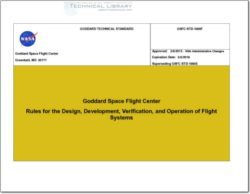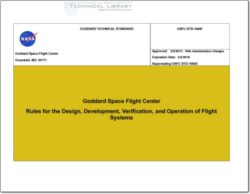NASA-GSFC-STD-1000F

- Version
- 235 Downloads
- 1.91 MB File Size
- 1 File Count
- May 14, 2016 Create Date
- May 14, 2016 Last Updated
Rules for the Design, Development, and Operation of Flight Systems

INTRODUCTION
Purpose:
The Goddard Open Learning Design (GOLD) Rules specify sound engineering principles and practices, which have evolved in the
Goddard community over its long and successful flight history. They are intended to describe foundational principles that “work,”
without being overly prescriptive of an implementation “philosophy.” The GOLD Rules are a select list of requirements, which
warrant special attention due either to their historical significance, or their new and rapidly evolving nature.
The formalization of key requirements helps establish the methodology necessary to consistently and efficiently achieve safety and
mission success for all space flight products. The GOLD Rules share valuable experiences, and communicate expectations to
developers. Where appropriate, the rules identify typical activities across lifecycle phases with corresponding evaluation criteria. The
GOLD Rules also provide a framework for the many responsible Goddard institutions to assess and communicate progress in the
project’s execution. The GOLD Rules ensure that GSFC Senior Management will not be surprised by late notification of
noncompliance to sound and proven engineering principles that have made GSFC missions consistently successful. Each GOLD
Rule specifies requirements in the form of a Rule Statement, along with supporting rationale, and guidance in the form of typical
lifecycle phase activities and verifications.
Scope:
The GOLD Rules focus on fundamental principles and practices, and therefore are intended to apply to all space flight products,
regardless of implementation approach or mission classification. Whenever necessary, rules clarify requirements and expectations
consistent with different mission classifications. Although not expected to be required, an a priori Mission Exceptions List (MEL) may
be proposed at the start of a Program and/or Project, to highlight rules which may not apply. If a MEL is submitted and approved,
waivers will not be required for exceptions covered by the MEL unless changes occur to the underlying basis for exception. For rules
that include multiple elements (e.g., “test as you fly”) waivers and exceptions are valid for the specific elements indicated in a MEL or
waiver and do not constitute a global approval to waive all elements of that rule. Other exceptions that arise during execution of the
mission still require waivers, as appropriate. A MEL approved at the program level for multi project programs will be reviewed at key
points in the program lifecycle (e.g. At the release of a new Announcement of Opportunity) to validate its applicability for new
Projects.
The GOLD Rules is a living document, periodically assessed and updated to improve its clarity of purpose and effectiveness. While
the engineering principles and practices are stable, the select set of requirements may evolve based on whether they continue to
warrant increased visibility by their inclusion. The intent is to improve the GOLD Rules over time, not to grow it in size, complexity,
and coverage so that it becomes more cumbersome and less helpful over time. Requirements temporarily included because of their
new and rapidly evolving nature, must be accompanied by transition plan out of GOLD rules and into an appropriate lower level
document.
GSFC Rules are governed by GPR 8070.4, configuration-controlled and accessible to all GSFC employees. A technical authority
designated for each rule will be responsible for requirements validation, rationale verifications, related guidance and lessons learned,
and participation in the evaluation of proposed changes and waivers.
NASA/GSFC Processes and Rules Hierarchy
| File | Action |
|---|---|
| NASA-GSFC-STD-1000F Rules for the Design, Development, and Operation of Flight Systems.pdf | Download |

Comment On This Post